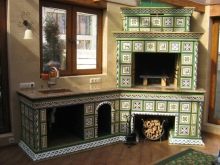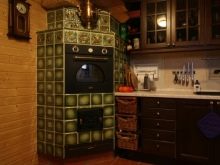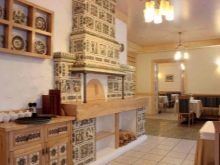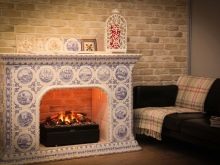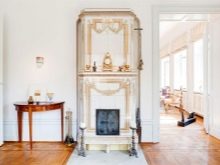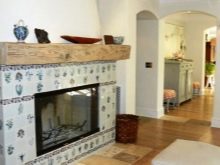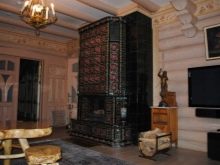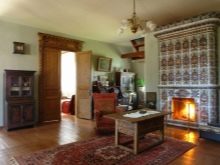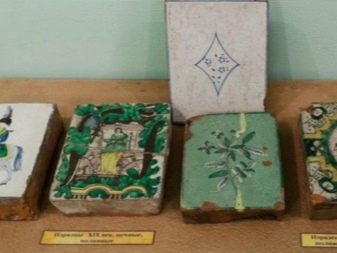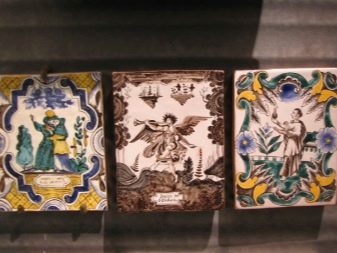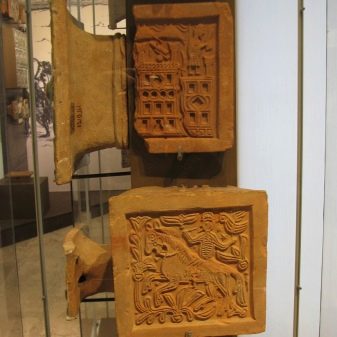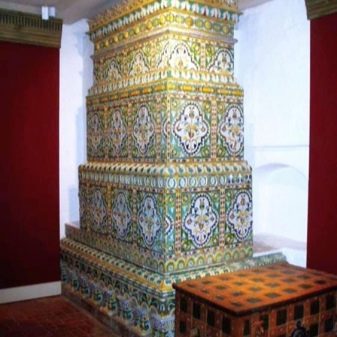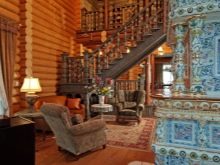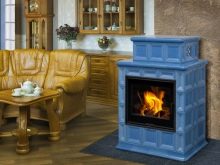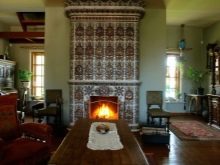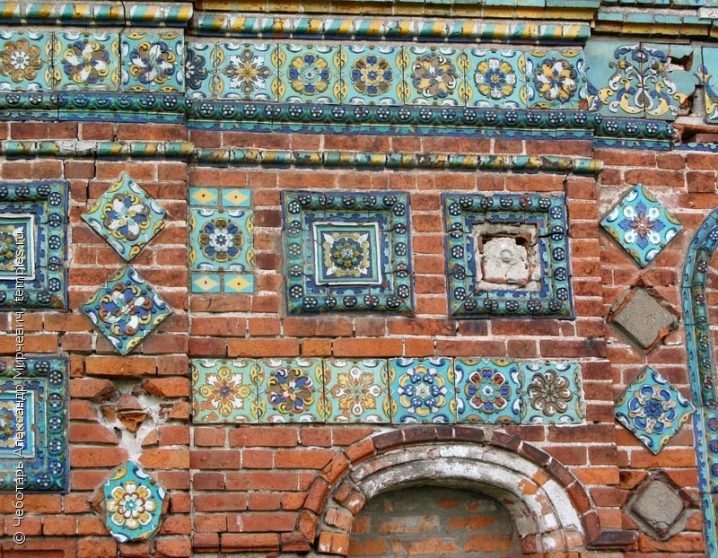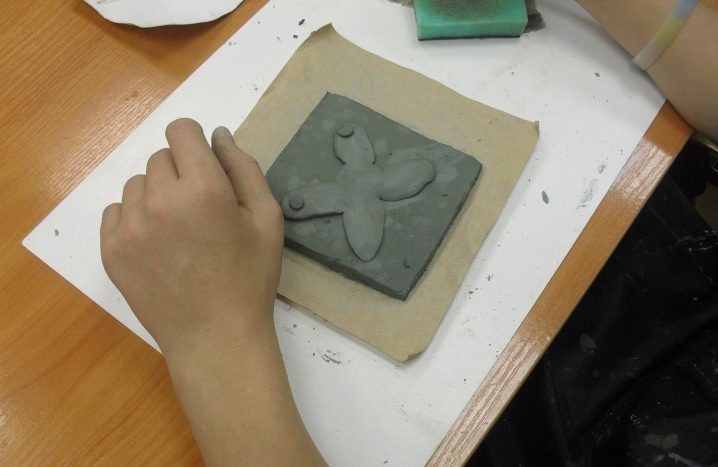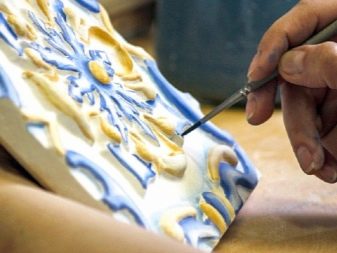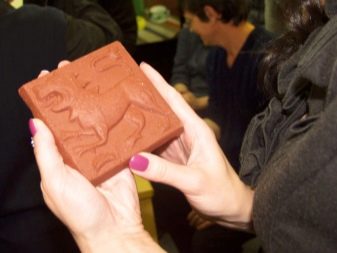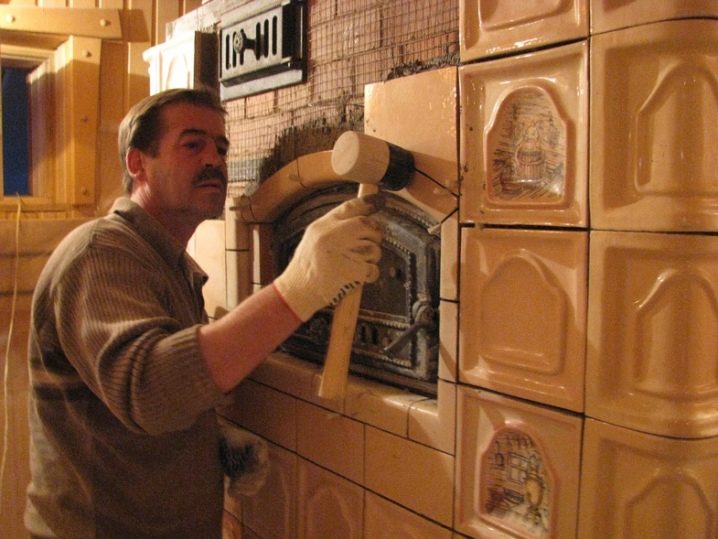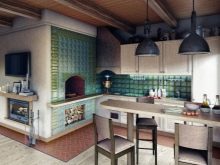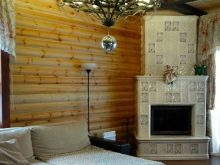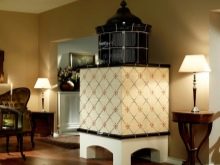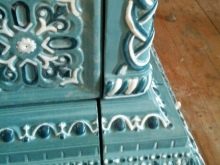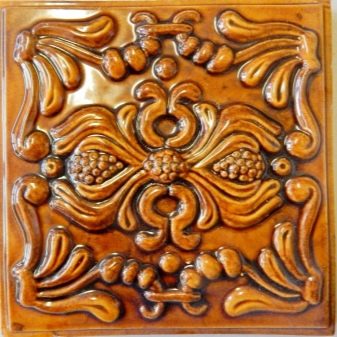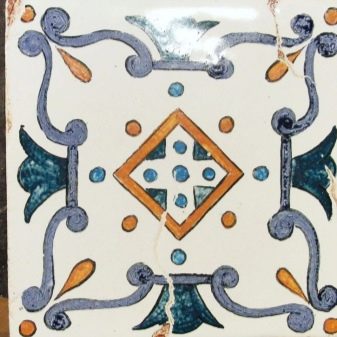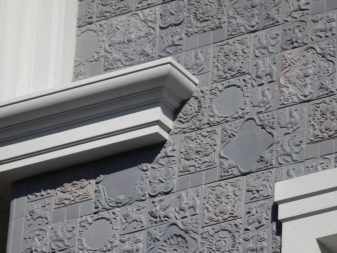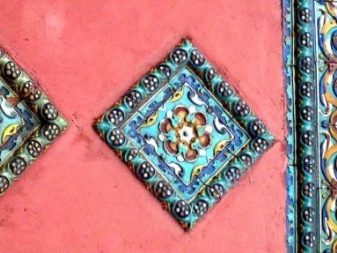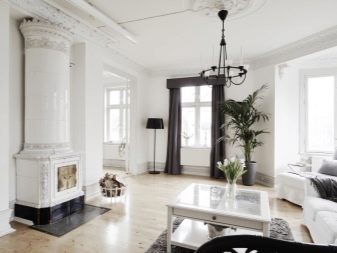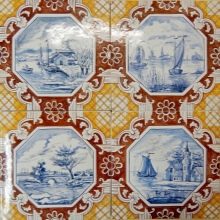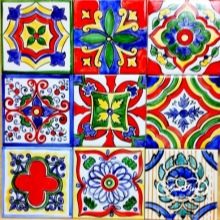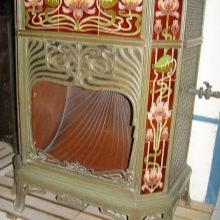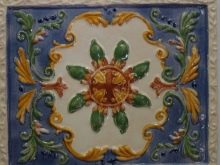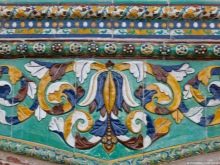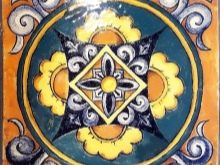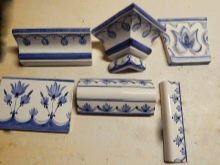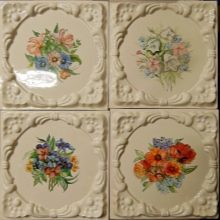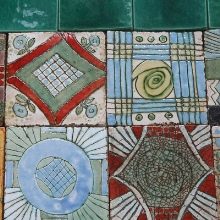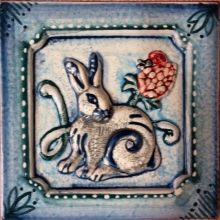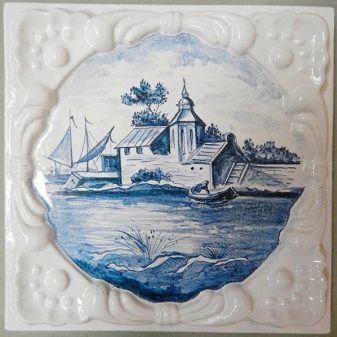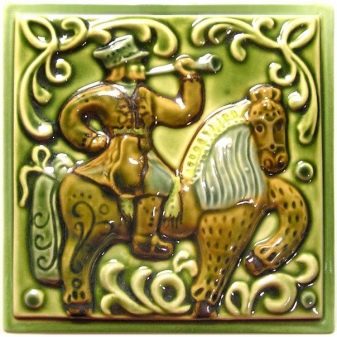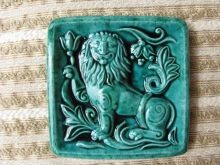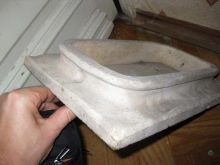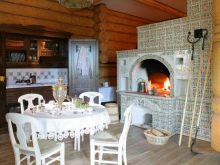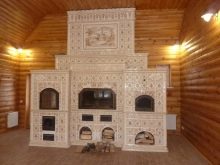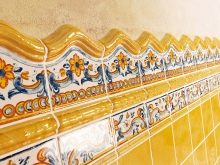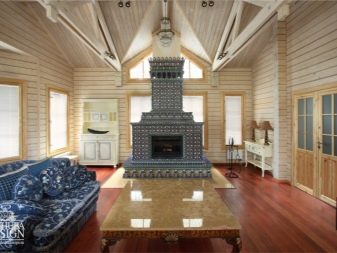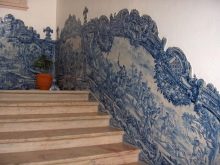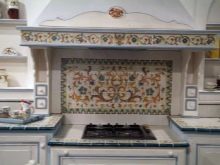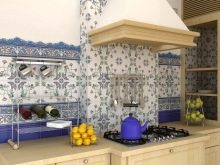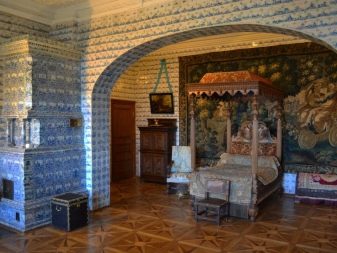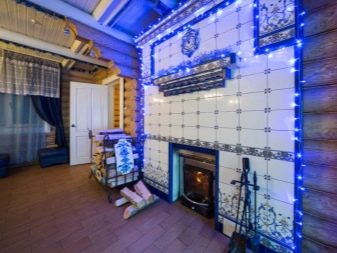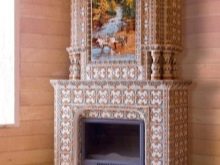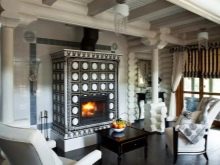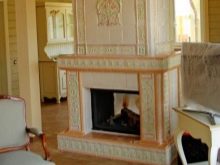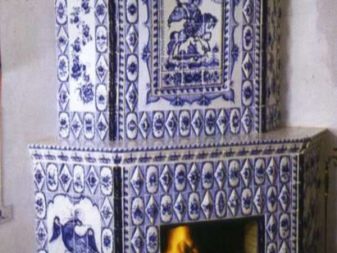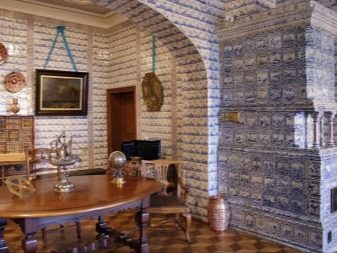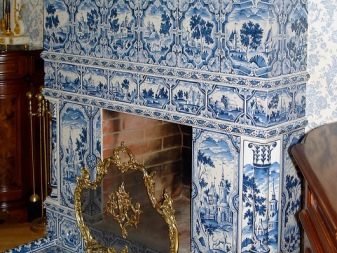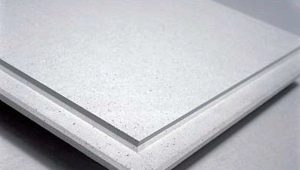Tiles: manufacturing features and examples of use in the interior

Today the construction market offers a lot of modern finishing materials. However, those that were used by our ancestors do not lose their relevance. An example of this is clay tiles, in which there is a special tribute to the traditions, the atmosphere of home warmth.
What it is?
The tile is a clay tile, the production of which involves high-temperature kiln firing. Ceramics differs from tiles mainly because they have a characteristic perimeter rim on the seamy side. It is called tiller and simplifies the process of laying, and also provides fixation strength and increases the heat capacity of the material.
Today, tiles are widely used as decoration for a stove or a stationary barbecue, kitchen apron, living room walls, hallway, study and even a nursery.
A wide range of applications due to the characteristics of the material, the most significant of which are considered:
- high strength, due to the thickness of the tile (it is 2 times stronger than the ceramic counterpart);
- water resistance (the glazed surface of the tile literally pushes water away from itself);
- resistance to high temperatures, as well as resistance to temperature "jumps";
- good thermal performance due to the ability to accumulate heat (heated furnace, lined with tiles, gives off heat for a long time);
- mechanical stability, wear resistance;
- environmental safety associated with the natural composition, as well as the fact that the dust on the surface does not linger;
- safety of use of the furnace, protection of its external walls from overheating;
- ease of care;
- long term use;
- authentic appearance, the ability to use to create original interiors.
The name "tile" comes presumably from the verb "cut." Previously, for the manufacture of products used wooden forms, which poured raw materials.The more skillfully the shape was made (cut out), the more interesting the tile was.
Special features
The history of the appearance and development of tiles in Russia is inextricably linked with the history of the development of the art of brickwork. In the old days, when the stoves were primitive stoves that were blackened, there was no point in decorating them.
However, with the development of the construction of stoves with a chimney, the art of decorating a stove began. At first, for these purposes they tried to adapt the clay tile used for wall and floor decoration. However, such a lining on the furnace quickly fell into disrepair, because the material could not withstand the high temperatures of the heated furnace.
A little later, in the XVI century, the first stove tiles appeared. They consisted of a tile with a clay pattern, mainly depicted patterns, floral ornaments, animals, pictures from rural life.
In the 17th century, tiles were coated with glaze, similar in their properties to modern glaze. From this period begins the flowering of tiled art, which continued until the XIX century. During this period, the tiles differed in size, they were applied bright ornaments, laid out the whole picture.
At first, the tiles decorated not only the furnace and the internal elements of the house, but also the facade of the building. However, approximately from the XVIII century in Russia, tiles began to be used less and less frequently in architecture; over time, they completely ceased to be used for exterior cladding.
Manufacturing technology
Tiles have a high cost, due to the fact that most of the technological processes (including painting) are done manually.
The basis of the material is purified terracotta clay. Previously, it was poured with water and left for several days, after which it was drained, leaving only a greasy residue, which was sieved and left to "rest."
Today, the cleaning process is automated, but the finished product is also given several weeks for proofing. After that, the raw material is placed in the form.
It is important to bear in mind that the clay shrinks by 5-10%, therefore the size of the form is slightly larger than the size of the intended finished product. Previously, the forms were clay, today it is gypsum counterparts.
After that, the clay dries naturally. It is important to maintain a certain indoor climate at this time.Accurately set and observed indicators of temperature and humidity, unacceptable the appearance of drafts. If this mode is violated, the finished product will be brittle and cracked.
The next stage is kiln firing, then drawing and glazing and final firing.
As a rule, tiles are made to order, taking into account the area and shape of the surfaces to be veneered. This allows you to accurately calculate the size and number of tiles and, consequently, reduce customer costs.
However, on the shelves of building stores you can find tiles that are as close as possible to hand-made tiles, but made by the factory method. Their cost is quite affordable. When using tiles, do not use ordinary adhesive and cement mortars for facing the furnace. Like brick, such tiles are fixed on refractory glue or clay.
Kinds
Tiles retain the properties described above only if they are used intact. Cutting material reduces to zero the heat-accumulating ability of the tile. In this regard, each element of the furnace or room (walls, corners) needs a special type of tile.
Depending on the form (and purpose), tiles can be of the following types:
- frontal - they are also called flat because they are intended for lining flat surfaces;
- corner - designed to design corners;
- shaped - are considered decorative, as they are used for lining protruding elements, as well as a zoning element.
If the classification is based on the features of the structure of the face of the tile, then the tiles are as follows:
- embossed - as a rule, emphasize the simplicity and conciseness of the drawing;
- smooth - usually have a complex or bright pattern.
Tiles can simultaneously combine relief and pattern. However, there are white or colored tiles with relief, or tiles that have only a pattern (for example, Dutch).
If the criterion is the type of external surface, then the material is divided into types:
- glazed or glossy tiles;
- not glazed (they are also called matte or terracotta).
The presence of glaze in many ways provides indicators of the resistance of the material to moisture, mechanical damage, causes a more complex or simple care.Glaze is characterized by resistance - it has not been abraded and cracked for decades.
Among glazed tiles emit irrigation. When making them, they first cover them with one color, on top of which they are painted with colored glaze. Such tiles are called “precious”, they are distinguished by a bright appearance.
Depending on the presence of the pattern, tiles are selected with a pattern and not having one. Tiles without a pattern are painted in one color, it is possible to preserve the natural shade of clay. The use of such terracotta shades provides an imitation of clay walls. Tiles with a pattern, in turn, can have several varieties depending on the ornament applied to the surface.
Among the most famous tiles with ornaments highlight:
- Dutch Such a tile is distinguished by a bright blue ornament on a snow-white background. The plot of the pictures usually become ships, sea spaces, pictures from the lives of shepherds, millers.
- Spanish On such tiles there are complex oriental motifs, characterized by the use of 2-4 bright colors. Oriental painting is usually superimposed on a dark background.The tiles are usually square, with a small light ornament throughout the area.
- German. Characterized by geometric accuracy of the applied patterns, concise image.
- Russians. Admire the variety of ornaments and the riot of flowers. It is characteristic that each of the regions had a special style of painting the tiles, which became the "calling card" of local craftsmen. Previously, people could determine in which region the tile was made, having carefully considered its ornament.
- Yaroslavl. This tile is a kind of Russian, published in a separate group due to the complexity of the applied pattern and muted colors. As a rule, the pictures are zoomorphic or patterns with floral ornaments, as well as scenes of a simple village life.
- Kaluga. They have the shape of an elongated rectangle, which determines the location of the picture. Along the perimeter, the tile usually has a bright border, white or light itself, in the center - a small pattern. Depicted mostly plants and flowers. However, there are Kaluga tiles with the image of people and household items, the general technique of painting does not differ from that described above.
- Ants A distinctive feature of the etched tiles is a rich green grassy or emerald shade. Previously, this effect was achieved by applying a special glaze of green hue. The images on such a tile are minimalist, in most cases they are convex embossed details. The relief contour is usually highlighted by a darker shade.
- Italian. They have a rich color palette with a predominance of yellow, red, light green and terracotta. Patterns have simple geometric shapes, large.
- Gzhel. The most popular and widely known pattern for our compatriots. Flowers and plants, animals, pictures from village life are depicted on a white background in blue or blue.
Among the most popular ornaments are:
- Floral and vegetable. There are in all cultures, they can have both realistic and fantastic, fabulous appearance.
- Abstraction. Suggest a combination of rhombuses, squares, stripes. Such patterns have traditional and modern tiles.
- Zoomorphic. On such tiles animals are depicted.For European and Russian cultures, it is characteristic to apply realistic images on tiles, for Eastern ones, mythical creatures.
- Landscapes. In its pure form, such ornaments are rare. The image of nature usually complements ornaments with animals or tiles with painted scenes from rural life.
- An image of people's lives. As a rule, holidays and working days of the peasants were depicted. On the European tiles sometimes there are images of warriors, horse riders.
Different models differ from each other and the type of rumpy. Depending on this emit:
- simple tiles - rumpa in them has an inclined cut;
- tiles with a side - the side has a hole for fasteners, which is the reason for more reliable fixation of such products;
- products with a complex pattern rumba and several cameras between the sides - the so-called cloisonne.
Depending on the method of manufacturing tiles, there are hand-made (unique but expensive) and factory-made (standard, but cheaper). If we talk about factory-made products, then Belarusian, European and domestic tiles have a high rating of specialists.But the models of Chinese and Indian origin are often produced of poor quality - drawing on them is wearyed in the first year of operation.
Dimensions
Each manufacturer adheres to its own dimensional tables with the release of tiles. In general, the tile has a thickness in the range of 4-5 cm. The most convenient, and therefore popular sizes are 20x20 and 22x22 cm for round products, 20.5x13 cm for rectangular ones.
Small tiles can have dimensions of 10x10 cm (square) or 10x15 cm (rectangular).
Scope of application
Most often, tiles are used to decorate the front parts of fireplaces and stoves. This immediately gives the interior originality, authenticity.
It is important that tiled stoves heat well, stay warm for a long time, but do not burn at the same time. Heated pottery produces heat comparable to that of the sun, so we can talk about its safe and beneficial effect on the human body.
The fireplace or stove has long been considered the center of the room, its important element. In this regard, it is not accidental desire to highlight this part of the original design. Modern fireplaces lined with tiles, especially look good in the village interiors, houses, made in the style of the Russian manor.
Often tiles are used for wall decoration.As a rule, it is a small panel or other surface area that differs from the rest of the zone.
Products that mimic antique tiles, as well as rare tile patterns, are a kind of antiques. The most appropriate such collections look in the office, library.
The functionality of the tile, as well as the atmosphere of family comfort and warmth that they bring to the interior, has led to the widespread use of tiles on kitchen surfaces. Among the popular options - finishing kitchen apron, partitions, the outer panel of bar counters.
Multi-color options are good for "country" and oriental styles, quiet monochrome tile patterns - for classic interiors. In any case, the use of a tile house fills it with a special aura - the aura of the family, continuity of traditions, and home hearth.
Beautiful examples in the interior
Tiles are traditionally used in the design of the kitchen, facing fireplaces, but with proper placement, they are no less relevant in other rooms.
Colorful painted tiles become the accent of the interior, so the whole interior should be discreet and well thought out.
- Tile in the interiors in the spirit of country, classical and neoclassical interiors looks natural. The apron of the kitchen set, the stove, the walls in the bathroom are subject to facing.
- If you are not close to the drawings and ornaments, choose monochrome models of soothing shades, the decoration of which is a relief pattern. Such a decoration is appropriate in concise interiors, minimalism style.
- In classic interiors in the style of a Russian manor, it is not forbidden to lay out the entire fireplace portal as well as the wall adjacent to the fireplace with tiles. However, such a solution looks appropriate only in large rooms.
Due to the variety of tile models, it is possible to find "one's own" option for any room. Bright patterned tiles usually become the accent of a room, used optionally. If you use light samples without a pattern, then you can finish them with larger dimensions.
By the way, the bright glossy tile visually allows you to increase the space of the room. Arrange the veneered element in such a way that it will not reflect the rays of the sun. Reflecting from the shiny surface of the tile, they will create indoors an interesting play of light and shadow, glare.
For calm in color and style of interiors, you can use bright, but at the same time refined Yaroslavl tile. For example, painting floral ornament with large applied elements.
Gzhel (traditional blue and white combination) organically looks in the style of country, Provence, as well as in classic interiors. Combine Gzhel tile with plain blue, white or blue to get a bright but unobtrusive interior.
For discreet, elegant interiors, Dutch tiles can be recommended, with patterns that are written down to the smallest detail. Thanks to this, the tiles look like miniature pictures and become an exquisite element of decor.
Tiled surfaces are well combined with natural stone, wood, and ceramic tiles.
For details on the production process and types of tiles, see the video below.
